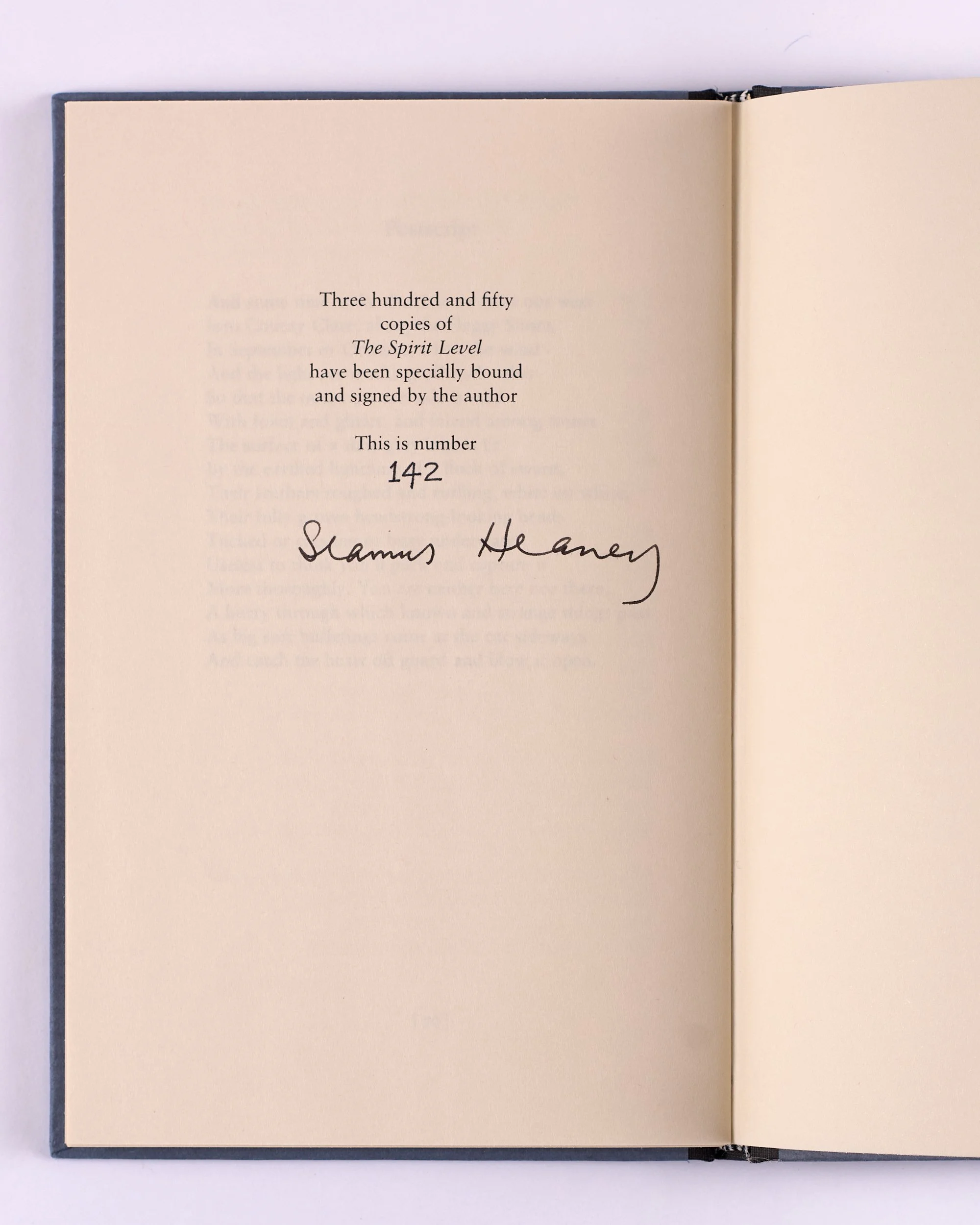 Image 1 of 3
Image 1 of 3

 Image 2 of 3
Image 2 of 3

 Image 3 of 3
Image 3 of 3




The Spirit Level
HEANEY, Seamus
The Spirit Level
London: Faber and Faber, 1996
8vo., black cloth-backed blue paper-covered boards; printed paper label to spine; pp. [x], 70, [iv]; a fine copy, in the publisher’s matching slipcase.
Limited edition, one of just 350 numbered copies specially bound and signed by the poet. This copy no. 142.
[together with]
8vo., green boards lettered in gilt to spine with publisher’s device to head; together in the unclipped pictorial dustwrapper (£14.99 to front flap); pp. [x], 70; the book fine, the wrapper just a little scuffed and rubbed at spine tips, with some light shelf marking to the upper panel
First edition.
[and]
A single-sided TLS, addressed to a ‘Andy Vaughan’ on Heaney’s addressed notepaper (14.5 x 18.5cm approx); folded once horizontally and signed by the poet; a little creased, some residue to verso from sometime being stuck down; very good.
“Good ideas about the title for the book” Heaney writes, “I’’m never sure until the last minute about these things. But, in fact, the manuscript is [‘s’ corrected in ink pen] not quite settled yet, so there will be a long period of uncertainty ahead. I have an inclination to call it The Flaggy Shore, which is the name of a place in County Clare mentioned in one of the poems; but also it has a nice double meaning, I think, in that “Flaggy” can mean either stony or hung with flags. So there y’are!”
In the end, the finished book was titled ‘The Spirit Level’, with the aforementioned ‘Flaggy Shore’ appearing here only in the postscript at the rear of the volume: “And some time make the time to drive out west / Into County Clare, along the Flaggy Shore…”
A collection of 40 poems, and his first since winning the Nobel Prize for Literature in 1995 "for works of lyrical beauty and ethical depth, which exalt everyday miracles and the living past." The final title which Heaney decided upon refers to the carpenter’s tool used for creating balance across a flat surface, and is of course used metaphorically; a sentiment which is perhaps best illustrated in ‘The Poplar’ (p. 50), his poem of just four lines which reads:
Wind shakes the big poplar,
quicksilvering
The whole tree in a single sweep.
What bright scale fell and left this needle quivering?
What loaded balances have come to grief?
Peppered with personal references, Richard Tillinghurst wrote in his New York Times review that “[Heaney’s] poems, resting at the balance points between what we see as opposites, can make us realize that at times our vision utterly deceives us…Anyone who reads poetry has reason to rejoice at living in the age when Seamus Heaney is writing.”
The Spirit Level won the Whitbread Book of the Year award in the year of publication.
A unique association set, together with a letter from the poet discussing his ideas about the title.
HEANEY, Seamus
The Spirit Level
London: Faber and Faber, 1996
8vo., black cloth-backed blue paper-covered boards; printed paper label to spine; pp. [x], 70, [iv]; a fine copy, in the publisher’s matching slipcase.
Limited edition, one of just 350 numbered copies specially bound and signed by the poet. This copy no. 142.
[together with]
8vo., green boards lettered in gilt to spine with publisher’s device to head; together in the unclipped pictorial dustwrapper (£14.99 to front flap); pp. [x], 70; the book fine, the wrapper just a little scuffed and rubbed at spine tips, with some light shelf marking to the upper panel
First edition.
[and]
A single-sided TLS, addressed to a ‘Andy Vaughan’ on Heaney’s addressed notepaper (14.5 x 18.5cm approx); folded once horizontally and signed by the poet; a little creased, some residue to verso from sometime being stuck down; very good.
“Good ideas about the title for the book” Heaney writes, “I’’m never sure until the last minute about these things. But, in fact, the manuscript is [‘s’ corrected in ink pen] not quite settled yet, so there will be a long period of uncertainty ahead. I have an inclination to call it The Flaggy Shore, which is the name of a place in County Clare mentioned in one of the poems; but also it has a nice double meaning, I think, in that “Flaggy” can mean either stony or hung with flags. So there y’are!”
In the end, the finished book was titled ‘The Spirit Level’, with the aforementioned ‘Flaggy Shore’ appearing here only in the postscript at the rear of the volume: “And some time make the time to drive out west / Into County Clare, along the Flaggy Shore…”
A collection of 40 poems, and his first since winning the Nobel Prize for Literature in 1995 "for works of lyrical beauty and ethical depth, which exalt everyday miracles and the living past." The final title which Heaney decided upon refers to the carpenter’s tool used for creating balance across a flat surface, and is of course used metaphorically; a sentiment which is perhaps best illustrated in ‘The Poplar’ (p. 50), his poem of just four lines which reads:
Wind shakes the big poplar,
quicksilvering
The whole tree in a single sweep.
What bright scale fell and left this needle quivering?
What loaded balances have come to grief?
Peppered with personal references, Richard Tillinghurst wrote in his New York Times review that “[Heaney’s] poems, resting at the balance points between what we see as opposites, can make us realize that at times our vision utterly deceives us…Anyone who reads poetry has reason to rejoice at living in the age when Seamus Heaney is writing.”
The Spirit Level won the Whitbread Book of the Year award in the year of publication.
A unique association set, together with a letter from the poet discussing his ideas about the title.

